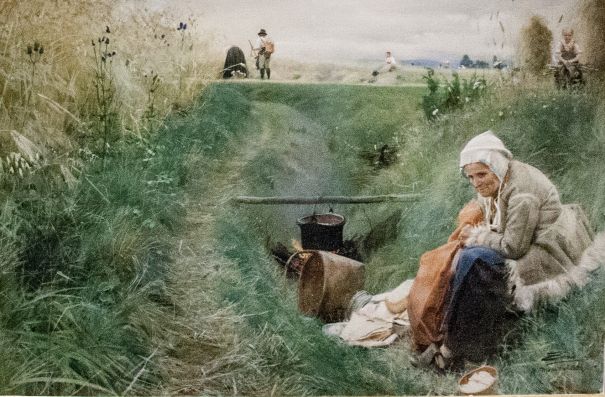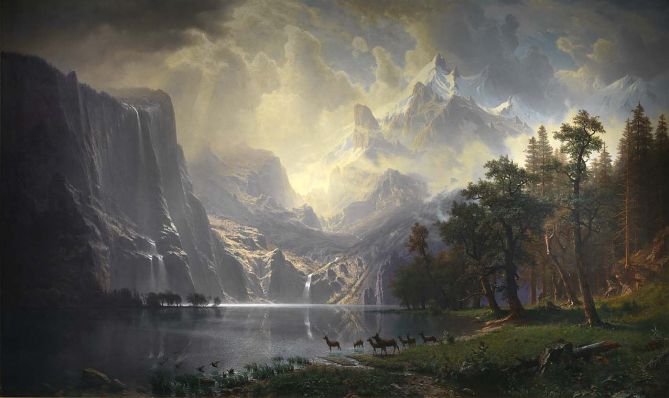Action Painting – Definition, Characteristics and Development
Contents
Definition of Action Painting
Action Painting is a kind of art, direct, instinctive and very dynamic that consists of the spontaneous application of vigorous and broad brushstrokes, adding the effects of drips and spills of paint on the canvas. The term was coined by the American critic Harold Rosenberg to characterize the work of a group of American abstract expressionists who used the method in 1950.
Likewise, action painting is distinguished as a carefully preconceived work by the abstract imagists, the color field painters, who constitute the other major direction implicit in abstract expressionism and who resemble action painting only, in their absolute devotion to personal expression unfettered by all traditional aesthetic and social values.
How did Action Painting develop?
Action painting is evidently represented in the works of action painters Jackson Pollock, Willem de Kooning, Franz Kline, Bradley Walker Tomlin and Jack Tworkov, who reflect the influence of the automatic techniques developed in Europe in the 1920s and 1930s by the Surrealists. Thus, surrealist automatism, consisted of scribbles engraved without conscious control by the artist, which was designed primarily to arouse unconscious associations in the viewer, observer. Thus, the automatic approach of the action painters was conceived primarily as a means of giving creative forces to the artist’s instinctive free play and revealing these forces directly to the viewer. Likewise, in action painting, the law of painting itself remains the moment of the artist’s creative interaction with his materials, which is as important as the finished work.
In this sense, it is generally acknowledged that Jackson Pollock’s abstract drip paintings, executed since 1947, paved the way for the bolder, more gestural techniques that characterize action painting. Thus, the vigorous brushstrokes of de Kooning’s “Woman” series, begun in the early 1950s, successfully developed a rich and emotive expressive style. At the same time, action painting was of great importance throughout the 1950s in Abstract Expressionism, which is considered to be the most influential art movement at the time in the United States. However, by the end of the decade, the leadership of the movement had shifted to the color and abstract imagist painters, whose followers in the 1960s rebelled against the irrationality of the action painters.
Tachism painting style
Tachism, especially French tachism, (tache, “dot”), is a style of painting practiced in Paris after World War II and through the 1950s which, like its American equivalent, action painting, features the brushstroke gesture of the intuitive, spontaneous artist. Developed by the young painters Hans Hartung, Gérard Schneider, Pierre Soulages, Frans Wols, Chao Wu-chi (Zao Wu-ki) and Georges Mathieu. Similarly, Tachism was part of a larger French postwar movement known as Art Informel, which abandoned geometric abstraction in favor of a more intuitive form of expression. Art Informel, therefore, was inspired by the instinctive, personal approach of contemporary American, so-called Abstract Expressionism, derived as one aspect, from action painting.
The Influence of Surrealism
Action painting was greatly influenced by Surrealism and the use of automatism in art to give free expression to the subconscious mind, as can be clearly seen in the above analysis. Likewise, action painting drew inspiration from Freud’s theories, glimpsed in the works of artists such as André Breton (1896-1966), the subconscious, surrealists André Masson (1896-1987) and Joan Miró (1893-1983), who were convinced users of this type of involuntary, spontaneous painting, all of which later had a significant impact on the abstract expressionists.

What are the types of action painting?
In action painting there are a series of characteristics that are important to highlight:
The texture of the paint
The movement of the artists hand
The field of color in painting
The reference to color and form.
The painter wanted to create peaceful and spiritual paintings.
There is no representative theme
On the other hand there are a number of techniques:
The Use of large brushes in splashed with paint on canvas.
The use of large canvases.
The painter wanted to achieve a spontaneous and vigorous effect, with broad brushstrokes to show emotion.
The Work placed emphasis on the process of painting rather than the finished piece
No representational subject matter
Spontaneity that could be drawn from unconscious mind (surrealism).
Drip painting
Drip painting is a form of abstract art in which paint is dripped or poured onto canvas. This style of action painting was experimented with in the first half of the 20th century by artists such as Francis Picabia, André Masson and Max Ernst, who employed the drip technique in their works. Thus, Ernst uses the new means of painting in the figures of Lissajous, balancing a perforated bucket of paint on a horizontal canvas.
Gestural Abstraction
Gestural Abstraction, is another derivative of action painting revealed in the exponents of abstract expressionist painting, in particular, Kline and De Kooning, who used similar methods although not to the same extent as Pollock. Among them, many of the traditional concepts of composition, space, volume and depth are discarded, allowing the flatness of the picture plane to take center stage. Similarly, these painters were hailed by art critics as the inheritors of an art tradition, extending to the water lily paintings of Claude Monet, whose defining characteristic is the making of marks on a flat surface, who formed the core of the “gestural abstraction” style of Abstract Expressionism. This highly active textural style contrasted with the silent idiom known as color field painting, practiced by the likes of Mark Rothko (1903-70), Clyfford Still (1904-80), Barnett Newman (1905-70), on the opposite wing of the movement.
What is the legacy of Action Painting?
The most important legacy left by action painting is its new trends, in different groups of creators who have used their techniques to spread the art of action painting. Thus, during the 1950s and 1960s, which were decades of high production, the focus shifted from the finished work to the processes of creation, generating installations, executions and environments, such as Allan Kaprow’s Yard tire field. Likewise, action painting was often executed in the presence of the public and spectator participation was sought. Also, the ephemeral nature of these actions meant that what remained of most of these works made in this ephemeral manner were photographs, videos and recordings documenting them.
On the other hand, in Japan, the artistic group Gutai was created, which means concrete, active between 1954 and 1972, which carried out similar experiences. Therefore, their conceptual approaches aroused the interest of the Western artistic avant-garde, showing existential and artistic concerns through parallel channels between East and West. The members of this Gutai group organized open-air exhibitions and performed actions such as painting with their feet hanging from ropes on the canvas (Kazuo Shiraga) or crossing the surface of the canvas by jumping and creating a passage (Saburo Murakami).
Another important legacy is the influence of painting as performance and performance as painting that also reaches the work of more recent artists, such as Janine Antoni, who in “Loving Care” paints on the floor with hair dye using her hair as a brush, turning these everyday actions into pictorial and sculptural processes, as well as incorporating women in a prominent role in artistic creation.
Who are the main representatives of action painting?
One of the greatest representatives of action art is Paul Jackson Pollock (1912-1956), who is an American painter who was an exponent of abstract expressionism, an artistic movement characterized by freely associated gestures, in painting called “action painting”. During his lifetime he received wide publicity and recognition due to the radical pouring or “drip” technique with which he used to create his large works. He was also respected among his contemporaries for his deeply personal and uncompromising commitment to the art of painting. His work and his example had enormous influence on other painters and on many later movements in the United States. Likewise, Pollock is also one of the first American painters to be recognized during his lifetime and was also a master peer in 20th century modern art.
Other artists who made important contributions to action painting include: Mark Tobey who is noted for his white style of calligraphic gesturalism; Franz Kline, an artist whose works include compositions of color field as well as vigorous gestural work, sometimes compared to the gigantically enlarged fragments of Chinese calligraphy; Robert Motherwell in his series entitled elegy to the Spanish Republic and his powerful black and white paintings; Cy Twombly, with his gestural works based on calligraphic symbols, and linear, as well as Adolph Gottlieb, known for his abstract surrealist series such as pictographs, imaginary landscapes and explosions.


